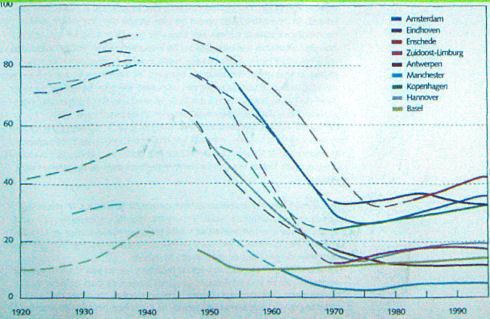I thank Ralph Fertig of the Santa Barbara, California Bicycle Coalition for drawing the attention of the bicycling community to the following fascinating travelogue from Copenhagen, shot in Technicolor in 1937. Not all of the film is about bicycling, but the bicycling scenes are worth the wait.
In 1937, bicycling had been the dominant mode of road transportation in Copenhagen for decades. No transition to motoring had occurred, as in the USA. Bicycling declined after WWII with the increasing popularity and affordability of motor vehicles, but has since recovered considerably with the construction of bicycle facilities and other measures to encourage bicycling, and extremely high taxes on new cars.
The film from 1937 shows some very interesting scenes of bicyclists interacting with the relatively few motorists, especially near the end. Interaction is mostly vehicular, and bicyclists establish the prevailing speed of traffic. Look at how they navigate a traffic circle, moving to the center to go straight through. Bicyclists conduct themselves much like motor scooter users I saw in Taiwan in 2002.
I also notice that the youngest bicyclists shown are in the early- to mid-teen years. That also comports with what I saw in Taiwan, and differs from the “eight to eighty” paradigm that must be accommodated only with separate facilities, or on streets where motorists operate very gingerly — eight-year-olds can’t reliably follow the rules of the road.
Clearly, pre-WWII Danes were experienced bicyclists, but on the other hand, there is some rather sloppy bicycling shown.
Gotta love the narration:
“…a people who have contributed to the stability and progress of the white race, for the Danes are the descendants of the courageous Vikings…”
I had mistyped Bikings 🙂
Those Vikings were rather ruthless expansionist warriors, actually (just ask the Scots) , and in 1937, the Danes were within a very few years of being invaded themselves by history’s most brutal exponents of the concept of the “white race.”
New York City bicycling advocate Steve Faust adds the following observations:
I think I recognize the bridge…just west of the center city,
if so, the roadway has been changed from 4 mixed roadway lanes with trolley tracks in the center,
to two motor lanes without any streetcars, and two cycle track lanes – one on each side for one way bicycle flow.
The pedestrian sidewalk space remains about the same width as in the film.The streets leading to and from the bridge have been given a cycle track treatment in place of the two motor lanes [sic], and probably are part of the bicycle speed paced green wave of traffic signals.
There is almost as much bike traffic on these streets today, plus more motor traffic volume, all on the same street width.
The major change besides the dedicated cycle tracks, is the use of the right hand left turn in a holding bike box on the far side of the intersection. This eliminates bikes having to merge across the car lane and possibly more critical, bikes don’t wait in the motor lane for a clear left turn, which waiting would block the relatively narrow motor lane – there are no left turn pockets.Cyclist waiting time is minimized by having a total 60 second traffic signal cycle time. A cyclist arriving on the green through light has less than 30 seconds to wait at the far corner for the cross street green light – a delay that might well be shorter than waiting for a clear left turn from the roadway. I’ve certainly stood for over 30 seconds in the middle of the road waiting for a safe clear left turn.
The bike box Steve is discussing is a two-stage turn queuing box, which serves only left-turning traffic.
The graph below is from a presentation by Dutch bicycle program official Hans Voerknecht given in Boston, Massachusetts, USA in November, 2008.
The mode share for Copenhagen is indicated by the green line that starts at around 40 percent in 1920, rises to around 55 percent either side of World War II, then falls and rises again to around 37 percent in 1995.
This widely quoted number, though, is for commute trips only. According to more comprehensive sources from 1995 and also from more recent years — see this posting — bicycle trips are around 22% of all trips in Copenhagen. Data from earlier years and especially from before World War II may have been collected differently.
Copenhagen still has a large bicycle mode share for a city in an industrialized nation. Despite the draconian measures to reduce motor vehicle use, and the many bicycle facilities installed since the 1960s, Copenhagen streets carry many more motor vehicles now than in 1937, and on many main streets, bicyclists are restricted to cycle tracks or lanes which become congested at peak travel times.
You may click on the image to see a larger version.

